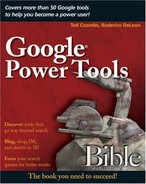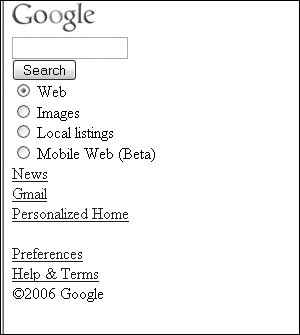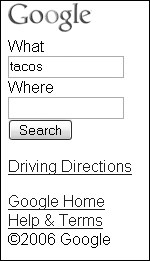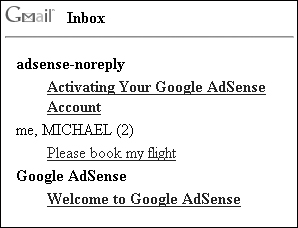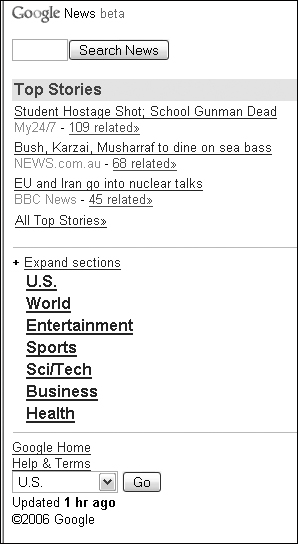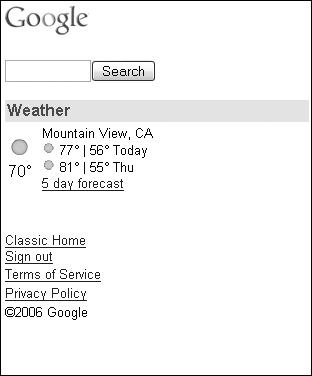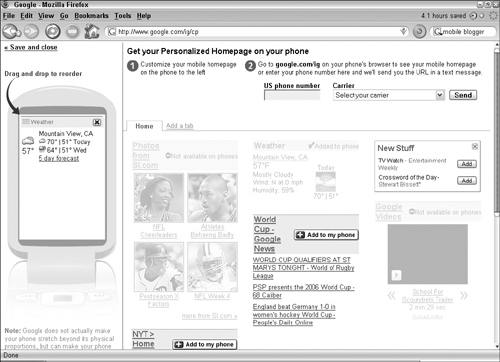Searching the Web on your mobile device
Configuring your mobile device for XHTML, WML, and iMode technologies
Using your Gmail account on a mobile device
Creating a mobile Web page
Using Google Mobile to list your mobile Web site in Google
Learning more about Mobile markup languages
The world’s information is at your fingertips when you have access to Google on your mobile phone or handheld device. In Chapter 27, you learned about finding directions using Google Maps on your mobile device. This chapter shows you that you can do even much more with mobile access to Google applications.
Many people have grown to rely on Google services, such as Gmail (see Chapter 19), searching the Web (see Chapter 1), Google Maps (see Chapter 27), and Blogger (see Chapter 25). These services are now available through your mobile device, whether it’s a cell phone or handheld computer. Learn how to use and configure these mobile services in this chapter.
Note
When this chapter refers to mobile devices, it means small devices such as cell phones, handheld computers, and PDAs. Yes, laptops with wireless modems are also wireless devices, but they do not require the special display technologies discussed in this chapter.
Google Web Search is great for settling arguments, finding an airline, comparing prices, and about a million other things that are all best when you have mobile access. You can use four formats for searching the Web with Google on your mobile device, depending on the technology it supports. The technologies are called XHTML, iMode, WML, and PDA. XHTML, iMode, and PDA can be used to access any of the 8 billion Web pages indexed by Google. WML is more limited, and Google provides a special search just to find pages created to fit mobile displays. The PDA (Personal Digital Assistant) interface is identical to that of XHTML.
To access the familiar Google Web search using XHTML (see the About XHTML sidebar nearby), point your mobile Web browser to www.google.com/xhtml. A Google Web search box appears, as shown in Figure 28.1. Type your search terms in the box. Then highlight the Google Search button, and click the button using the keys on your mobile device.
Note
If you are using a PDA, simply follow the directions for XHTML with one exception: To access the PDA interface, use www.google.com/pda.
Google displays ten results per page. This small number of results makes it possible to easily view them on smaller displays. It may take you a little longer to page through many results. To access the results, use the keys or thumbwheel on your mobile device that allows you to scroll through Web page elements, such as links and text boxes. Find the result you want to view, highlight it, and click Enter on your device.
By default, your search is through all Web pages indexed by Google. Be aware that even though Google does its best to reformat the Web pages so they are viewable on small displays, the page may not be viewable in your phone or handheld.
You can set a couple preferences for your mobile search using the XHTML interface. Point your XHTML-compatible device to www.google.com/xhtml/preferences. Here you find two preference settings: language and Google’s SafeSearch, as shown in Figure 28.2.
The interface display language is different from the languages you can use to search the Web. The display language is used to display the Google search page. To change the display language for Google tips and messages, select a language from the drop-down list. These are the choices:
Dutch
English
French
German
Russian
Set the SafeSearch level to eliminate or include results that may contain adult content. By default, this setting is set to Moderate. Switch between Strict, Moderate, and Off by scrolling to the level of your choice and selecting it with the Enter key on your device.
When you finish setting your preferences, scroll to the Save button and click it with the Enter key. Your preferences are saved, and you are returned to the search page.
WML (Wireless Markup Language), like XHTML, is based on XML. WML pages are supported on devices that use the Wireless Application Protocol (WAP). It is still supported by many mobile devices, but it’s quickly being replaced by XHTML. If your phone or device does not support XHTML or iMode (see the next section), try using Google’s support for WML by pointing your mobile Web browser to www.google.com/wml. Type your search terms, and click the Web button.
Because of its limitations, WML search results only display five search results per page. Move from page to page by highlighting and selecting the Next link at the bottom of the page.
The older WML technology does not allow most Web pages to be displayed easily or correctly on the smaller mobile screens, so Google provides the ability to limit your search to only Web pages that are formatted for the display of WML pages. To see a list of WAP-compatible pages, click the Mobile Web button rather than the Web button after typing your search terms.
Different from XHTML or WML, I-Mode (iMode) is a wireless communications technology developed by NTT DoCoMo that is very popular in Japan and gaining popularity throughout the world. Google has created a Web search page specifically for iMode-compatible devices. To perform a Web search using iMode technology, point your mobile Web browser to www.google.com/imode.
Use the same search techniques described in the preceding section on XHTML searching. Many mobile devices have a special I-Mode key to turn on this technology. If your device supports iMode, you may want to use this to search through Google.
Tip
You can change to a different language by appending a two-letter language code to the end of the URL used to access your search. Append ?hl= followed by the two-letter language code. For example, use www.google.com/imode?hl=fr to switch to French. Visit www.w3.org/WAI/ER/IG/ert/iso639.htm for a full list of two-letter language codes. This also works for XHTML.
Set the iMode preferences, language, and SafeSearch by pointing your browser to www.google.com/imode/preferences. See the section “Setting XHTML search preferences” for more information on setting the iMode preferences.
When you absolutely need to know if the person sitting in the back of the room is a famous TV star, do a Google Image Search right on your cell phone. For devices that support XHTML and iMode, you have the ability to search for an image just as you might from your desktop or laptop computer. Pointing your mobile Web browser to either www.google.com/xhtml or www.google.com/imode, you can enter a search term, as shown in Figure 28.1, scroll down to Images, press the Enter key on your device, and click the Search button. This selects the Images radio button; click the Search button to have Google find some images.
The search results appear, showing from one to three images per page depending on the display capabilities of your device. Each image appears with a number next to it. You can choose to view this image on its Web page by pressing the number on your device keypad or by scrolling to the image and pressing the device’s Enter key. Google then displays the page containing the image.
To continue to the next image, you can scroll down to the Next link and select it. To perform a new search, scroll down to the search box at the bottom of the page.
A fast way to find businesses or services in your area is to use the Local Listings search found on the Google Web search page. Just as with the image search, you can point your mobile Web browser to either the XHTML or iMode search page. Type the category of business you are looking for in the search box, scroll down to Local Listings, select it, and press the Search button.
After you press the Search button, Google prompts you for a location, as shown in Figure 28.3. Type a city, state, or other location in the Where box. For example, type Los Alamos NM. A comma is not required. Google is smart enough to know that NM in this example is the abbreviation for New Mexico.
The results for your search appear with the name of the business, the address, the phone number, and the distance from the location you typed. The more specific the location you type, such as a complete street address, the more specific the distance to the business.
As with Google Maps, the local listing includes a link to the business phone number so you can highlight the phone number and click to call. Clicking the name of the business launches a Google Map of the location and allows you to get driving directions. See Chapter 27 for more information on Google Maps and driving directions.
Some mobile Web browsers are compatible only with Web pages that have been designed for small screens using WAP (Wireless Application Protocol). Google allows you to do searches through just the pages that are WAP-compatible. You can perform this search by pointing your mobile browser to www.google.com/wml or by selecting Mobile Web from either the XHTML or iMode search pages.
The results appear with a link to the WAP-compatible Web page along with a short snippet from the page. Scroll to the link and press Enter on your device to view the page, or scroll to the Next link and press Enter to see more results.
One of the exciting things Google has added is the ability to use Gmail on a mobile device. From the XHTML search page, click the Gmail link. Gmail is currently available only using XHTML. When you sign in, your Gmail inbox automatically appears for you, as shown in Figure 28.4.
Note
You need to sign up for a Gmail account using a nonmobile Internet account before you can use it on your mobile device.
Scroll down to the e-mail message you want to read and click on it by pressing the mobile device Enter key. An e-mail “header” appears listing the sender’s name, the name of the recipient, the date the message was received, and the subject of the message. If there are attachments, they are listed in the header as links. Scroll to them, select the one you want to view, and click it with the Enter key.
Your mobile device must have an application that allows it to view files other than most standard image types. For example, if someone sends you an Excel spreadsheet, your mobile device needs Excel or a program that allows you to view Excel spreadsheets before you can view an Excel spreadsheet attachment.
One of the features of Gmail is to show you e-mail as threaded messages, so when an e-mail message has replies, you can view those as a list of message links. Selecting and clicking one of these links causes the message to appear, including the header described earlier.
The body of the message appears below the e-mail header. You may need to scroll to see the entire message. When you finish reading your message, you can choose to respond to the message using the standard Gmail message options.
You may need to scroll further below the body of the message to view the Gmail message options, which appear beneath the text of the message. To move to the next message, simply click Next conversation. To respond to the e-mail you are viewing, select one of the Gmail options by clicking the number listed before the option or by scrolling with your mobile device and pressing Enter. These are your options:
Reply: Reply to this message by sending a return message to the sender only.
Reply to all: Reply to this message by sending a return message to the sender and all other recipients of the message.
Forward: Send a copy of this message to a new recipient.
Archive: Create an archive of this message.
Mark unread: Mark this message as though it has never been read.
Add star: Add a star to this message to mark it.
Trash message: Send this message to the trash.
Compose Mail: Create a new e-mail message.
Inbox: View your inbox.
Two additional selections appear below the numbered menu. These are Contacts, which allows you to view your list of contacts, and more views, which allows you to select other Gmail folders and labels.
By selecting the more views option, you are presented with a list of folders that can be included in the list that appears on the main Gmail page when viewing it in your mobile device. It is wise to include only those folders you view on a regular basis to limit the amount of space used by the list of folder options.
At the bottom of the list of options, a Google search box appears that allows you to search your e-mail. Type a search term in the search box, and click Search Mail. Your search results appear listed as links. Scroll to the message containing your search term, and press Enter on your mobile device. You see the number of search results listed. You may need to continue to the next page of messages. Because they are listed from newest to oldest, click the Older link to continue to the next page of older messages. This link changes to Newer after you continue to the next page, allowing you to return to the previous page of messages.
Tip
For more information about Gmail and its features, see Chapter 19.
Google News gathers news stories from thousands of news sources and updates Google News viewers as the stories are reported. There is no need to be out of touch with the news simply because you are not sitting in front of your computer. Use your mobile device to read Google News.
Point your mobile Web browser to www.google.com/xhtml. From the XHTML search page, scroll down to and click the News link. This launches Google News (XHTML version), as shown in Figure 28.5.
Below the Google News search box are links to the Top Stories. To save space on your mobile device, the news “headline” is displayed without the normal Google News snippet of the article. You can still see the name of the news source and find a link to the related articles.
Scroll to the news story that interests you, and click it by pressing Enter on your mobile device. Clicking a news story causes you to navigate away from the Google News site. Each of the news sources for Google News provides an XHTML interface to its stories. Each news source appears formatted in a slightly different way and provides different options for things like moving to the next page of an article or reading other stories. You need to use your mobile Web browser’s Back button or option to return to Google News on your mobile device or start over by typing www.google.com/xhtml and selecting News. Remember that Google News is updated constantly, so the information that appears may be different each time you launch Google News.
To see all the Top Stories, scroll to the last link in the Top Stories section of Google News and click the All Top Stories link. This launches a page listing the top ten stories along with a link to return to Google News.
Under the Top Stories section, you see a list of the various news sections, including these:
U.S.
World
Entertainment
Sports
Sci/Tech
Business
Health
You can click any of these sections, or you also may see all the sections expanded to show the top news stories in each section by clicking the + Expand Sections link located just above the list of sections. When you want to collapse the sections, scroll through each of the sections until you reach the − Collapse Sections link. Clicking this link returns Google News to its default appearance, showing only the Top Stories with links to each section.
Selecting one of the sections, such as U.S. or World, presents you with a list of the top ten stories in that section. You can return to the Google News main page by clicking the Back to Google News link at the bottom. Of course, you can search the news using the search box found on each Google News page. Remember that, when reading stories, you are no longer on the Google News site, so the search box does not appear.
Typing a search term and clicking Search News returns a list of all current news articles containing your search term. You see links to ten news articles (with sources and links to related articles) per page. When there are more than ten results, you can move to the second page by clicking the Next link found at the bottom of the page. Move between pages by clicking the Prev and Next links.
Note
Some mobile device browsers support HTML and do not need to use the XHTML interface. These devices can simply use the Google News interface at http://news.google.com.
For more information about Google News, see Chapter 14.
You’ll love setting up your own Google Mobile home page because you can design your own home page to access the information that is really important to you. Similar to Google Desktop, you can see the weather, check stock prices, see movie showtimes, and, of course, keep up with breaking news right on your mobile device.
You can create a personalized home page for your mobile device that gives you access to the latest news, the weather, how-to information, and other items that Google provides, as shown in Figure 28.6. It’s a great start page to have on your phone.
Tip
You can view the same personalized home page on your desktop or laptop computer, but some items may not be visible on a mobile device.
To set up your Google home page, you need to use either a laptop or desktop computer with Internet access. You can’t use your mobile device to configure your home page. To get started, point your Web browser to www.google.com/ig/cp.
Several things are found on the Google Homepage Personalization page that you can add by clicking the +Add to my phone button found next to the item. Use the graphic mobile phone, shown in Figure 28.7, to configure the position of items on your home page. Items such as the New York Times news page are available, or you can click Add next to items in the New Stuff box. Some of these items are available on mobile devices but not on cell phones. These items are identified with the warning that they are not available on phones.
As you add items, you see them added to the graphic phone like the one shown in Figure 28.7. After they appear in the phone, you can reposition them by dragging and dropping them using your mouse or other pointing device. Remember that you must use your computer to configure your home page.
When you finish customizing your home page, you can point your mobile Web browser to http://google.com/ig, or in the Personalization page, you can type your mobile phone number, select your provider from the drop-down list, and click Send. A URL is sent to your phone for accessing your personalized home page.
Visit the Google Co-op Directory to find other sources of content that you can add to your home page. You can select from these items:
Latest
Lifestyle
Health
Information
News
Travel
Find the third-party provider of services that interest you, and click Subscribe below the logo. After you subscribe to the service, the button below the logo changes to Unsubscribe.
Google has created many partnership programs discussed in this book, and Google Mobile is no exception. The number of people accessing the Internet using their mobile phones and other devices is growing rapidly. More than ever, your site must be accessible to mobile users, and helping people find your mobile Web site is one of Google’s goals. You can partner with Google by adding Mobile Web Search to your site and making sure that Google indexes your mobile Web page.
You can add Google Search to your mobile Web site by signing up for Google Mobile and using the free copy-and-paste search service. Visit www.google.com/mobile/partner.html, and click Sign up for Google Mobile. Fill in the registration form, telling Google about your Web site. When you finish, click Submit.
Your mobile Web site must be compatible with one of the following mobile technologies:
XHTML
WML
iMode
PDA devices (standard HTML formatted for smaller displays)
A mobile Web page is one that has been formatted using one of the wireless technologies discussed throughout this chapter. At the very least, if you use HTML, it should be formatted for small displays. Create an account with Google Sitemaps to add your mobile Web page.
A site map is an XML page that lists information about your Web site. There are many reasons to create a site map. One reason may be that your site does not have pages that are easily found by Google’s Web crawler. A site map helps the crawler better index your site. The same is true for mobile Web pages.
The easiest way to create a mobile site map in the Sitemap protocol is to use the Sitemap generator script. This is an open source script downloadable from SOURCEFORGE.net. The URL is rather lengthy. You can type this or point your browser to www.sourceforge.net and search on google-sitemap_gen. Here is the URL: http://sourceforge.net/project/showfiles.php?group_id=137793&package_id=153422.
Your Web site must be running Python 2.2 or higher to use the Sitemap generator script. Webmasters must know how to transfer files to their site and run scripts.
You also can manually create a site map using the Sitemap XML protocol. You should be familiar with creating well-formed XML pages. See full instructions for creating a site map here: https://www.google.com/webmasters/sitemaps/docs/en/protocol.html.
Please note that this site requires you to log in first.
Point your Web browser to www.google.com/webmasters/sitemaps. Add your mobile Web site to the list of sites that you manage. Your site then appears in a list of managed sites. In the Sitemaps list column, click the Add a Sitemap link. This launches the Add Sitemap page where you should choose a type from the drop-down list. There are only two selections. The first one is for adding a sitemap that describes a regular Web page. Choose the second option, Add Mobile Sitemap from the list. New form selections appear based on which selection you choose. After you create a site map using one of the techniques described in the preceding section, upload it to your Web site. Type the URL of the site map in “Step 3. My Sitemap URL is.”
Finally, select the markup language used by your mobile Web site from the drop-down list, and click Add Mobile Sitemap.
Stay on top of what’s new in Google Mobile technology by signing up for notifications of new Google products. Point your Web browser or mobile or desktop computer to www.google.com/mobile/submit_email.html, type your e-mail address, and click Submit.
You also can stay up to date by reading Google’s official blog at googleblog.blogspot.com.
Mobile devices, because of their small screens, have required a rethinking about the way information, particularly graphic information, is displayed on the small screens. The first tendency, in early mobile markup language implementations, was to leave out the graphics, or only include very small graphics. There are now more advanced solutions that allow full4 Web pages to scale down for viewing on a small screen. Here is an overview of the markup languages used to create Web pages viewable on small screens.
XHTML is the successor to HTML and technically the reformulation of HTML 4.0 within the strict formatting of XML pages. The reason for this reformulation of HTML is due to the number of devices now used to access the Internet. HTML is a “loosey-goosey” markup language that requires a fairly heavy-duty parser—a special translation program—to correctly display HTML. Mobile devices just don’t have the horsepower or resources to properly parse HTML, so switching to the very strict format of XML reduces the overhead necessary to properly display HTML.
WAP 2.0 is the latest version of the Wireless Application Protocol, the technology used by many mobile devices to provide Internet access. WAP acts as a gateway for XHTML content onto the mobile devices. Someday, WAP will be replaced by WIP (Wireless Internet Protocol), considered to be a true Internet protocol.
The official Web site for XHTML is www.w3.org/TR/xhtml1/.
Wireless Markup Language (WML) is an XML-based language used for displaying mobile Web pages. It is considered an older technology and is largely being replaced by XHTML. WML was the first language to be understood by wireless “micro-browsers,” which were created to conform to the WML 1.1 DTD (Document Type Definition).
The official Web site for WML is www.wapforum.com.
Japanese-based NTT DoCoMo decided to create a competing technology to WAP called i-Mode. I-Mode, or commonly iMode, uses cHTML, compact HTML, as its markup language to create Web pages for small mobile devices. cHTML is a significantly smaller subset of HTML, thus cutting down on the need to parse the full version of HTML tags. cHTML does not support common HTML features such as JPG image support, tables, image maps, multiple fonts and font styles, background colors and images, frames, and style sheets. Basically, it supports two colors, usually black and white. While still used largely in Japan, cHTML is being replaced by the more widely used XHTML.
The official Web sites for cHTML (in Japanese) are www.access.co.jp/ and (in English) www.access.co.jp/english/index.html.
Google has created a portal to the world’s information. With Google Mobile, you have access to this same information on your handheld wireless device. Search the Web using several wireless technologies. Check your Gmail account right from your phone. Reading the news and checking the weather are among the things you can set up on your own mobile Web page.
There are many Google applications available from your mobile device, even blogging. A blog, when created from a mobile device, is affectionately called a moblog (pronounced m_ blog) for mobile blog. You can find more information about Blogger Mobile in Chapter 25.
There’s more to mobile computing than e-mail and the Web. You can use Google to send SMS text messages. Find out more about Google SMS in Chapter 29.
